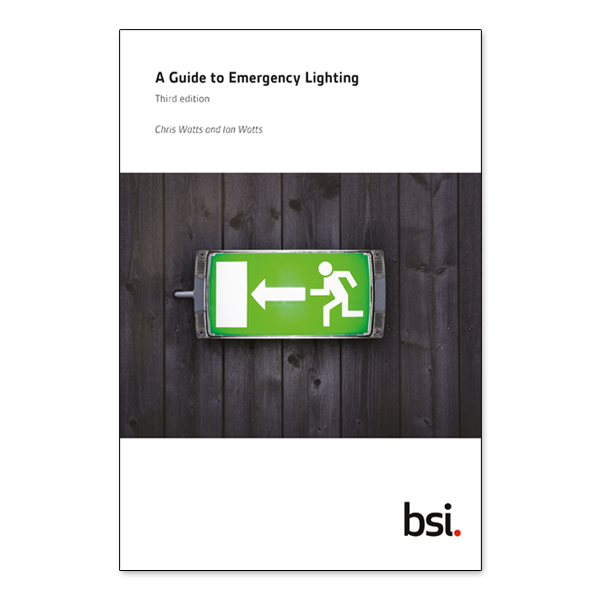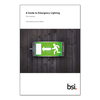BSI Guide to Emergency Lighting - 3rd Edition
Product code: PBSIELG20
£94.00 (Zero Rated)
Emergency lighting systems help occupants to leave premises safely in the event of a fire. BIP 2081:2020 is a companion guide to BS 5266-1:2016.
-
Product Description
What is BIP 2081:2020 about?
Emergency lighting systems help occupants to leave premises safely in the event of a fire. BIP 2081:2020 is a companion guide to BS 5266-1:2016.
Emergency lighting. Code of practice for the emergency lighting of premises. It interprets all aspects of the selection, design, installation, maintenance and testing of battery powered emergency lighting systems and helps users understand their legislative obligations.
Who is BIP 2081:2020 for?
Users and operators of premises on whom the legal duty of safety falls Emergency lighting project, design, installation and service engineers.
Other fire protection system engineers
Electrical contractors
Facilities managers
Fire protection companies
Architects, specifiers and consultants
Local and inspecting authorities including Building Control Inspectors
Emergency lighting and fire alarm manufacturers and suppliers
Why should you use BIP 2081:2020?
It gives comprehensive information and guidance on the choice, design and application of emergency lighting based on the latest versions of the appropriate standards and regulations.
The code of practice (BS 5266-1) details a number of forms of emergency lighting. This guide explains the merits of different systems and helps designers optimize a system for specific applications. It details the relative legislation and how the interface with the various fire safety systems should be applied to match the user’s fire risk assessment.
In addition BIP 2081:2020 details the design procedure, the installation and verification techniques, and the testing, servicing and repair procedures that should be adopted.
The final section explains the documentation steps and model certificates that should be raised to enable the user to demonstrate the suitability of the system to meet the protection required by their fire risk assessment.
BIP 2081:2020 can help users achieve UN Sustainable Development Goal 9 on industry, innovation and infrastructure because it contributes to the building of resilient infrastructure. It can help users achieve Goal 11 on sustainable cities and communities by making cities and human settlements safer.
What’s new about BIP 2081:2020?
This new edition has been updated to assist those engineers wishing to protect occupants from the hazards identified by risk assessments and has also been expanded to give guidance to protect occupants from sudden loss of the normal lighting supply.
It has been updated to refer to developing products and technologies such as the implications of the use of Light Emitting Diodes (LED) light sources and Lithium battery power sources and new central power and automatic testing systems. BIP 2081:2020 also includes information on the use of switched safety sign systems which allow building managers to direct occupants to the most suitable exit routes.
In addition to explaining the changes in BS 5266-1:2016, other relevant standards have been updated and information from the following new documents is also included:
a) BS 7273-6:2019 Code of practice for the operation of fire protection measures. Fire detection and fire alarm systems. Interface with ancillary systems and equipment This standard is important as it covers the interface of emergency lighting with other fire protection systems
PD CEN/TS 17165:2018 Light and lighting. Lighting system design process.
This technical specification specifies steps to be taken in lighting system design and lists responsibilities for the implementation and operation of the lighting solution.
Fire safety legislation places considerable responsibility on all those involved in designing, installing and manufacturing emergency lighting systems, to meet fire safety risk assessments. Users and their supporting engineers need appropriate knowledge of the legislation and relevant standard and product practices to ensure that requirements are correctly implemented. They also have to complete documentation to be able to demonstrate their systems conform to the requirements.
A Guide to Emergency Lighting – Third Edition helps users, designers and installation and maintenance engineers understand the legislative demand to provide appropriate emergency lighting systems. It covers all aspects of the selection, design, installation, maintenance and testing of battery powered emergency lighting systems. This edition has been updated to expand on the guidance given in the last Issue of BS 5266-1:2016, formalizing procedures when normal mains lighting fails. It gives guidance on the appropriate levels and location of emergency lighting as necessary.
This publication will be of wide-ranging appeal to all those involved in this subject, including: facilities managers; installation engineers; suppliers; system designers; system users; electrical contractors; engineers involved in maintenance of emergency lighting systems; installers; building control inspectors; fire protection companies; architects; local authorities; fire authorities; specifiers; and consultants.
Additional Details
Author IET ISBN (13 digits) 9780539131956 Knowledge Area Emergency Lighting
-
-
-
BSI Guide to Emergency Lighting - 3rd Edition
Emergency lighting systems help occupants to leave premises safely in the event of a fire. BIP 2081:2020 is a companion guide to BS 5266-1:2016.
£94.00 (Zero Rated)
-
-



